Showing all 18 resultsSorted by price: high to low
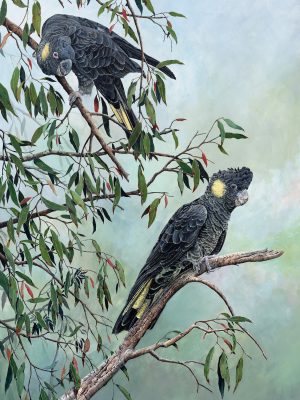
’I’m Up Here’! - Yellow tailed Black Cockatoos
Limited Edition print size: 100 cm x 80 cm. Printed on 310 gsm Museum quality art paper.
This is a signed limited edition print.
*Price includes postage anywhere within Australia.
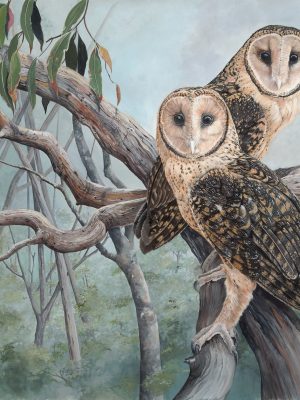
Limited Edition print size: 100 cm x 80 cm. Printed on 310 gsm Museum quality art paper.
'The Watchers' - Tasmanian Masked Owls
This is a signed limited edition print.
*Price includes postage anywhere within Australia
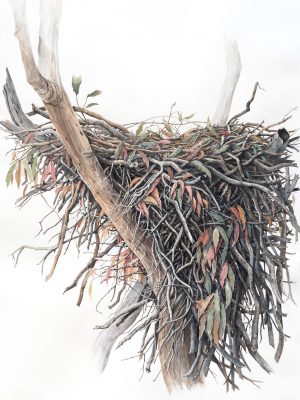
‘The Eyrie’ - Tasmanian Wedge-tailed Eagle Nest (Aquila audax fleayi)
Limited Edition print size: 100 cm x 80 cm. Printed on 310 gsm Museum quality art paper.
Wedge-tailed eagle nesting habitat is generally restricted to predominantly closed canopy old growth native forest, almost exclusively in tracts of tall eucalypt forest. Trees selected for nesting are among the largest in the locality, typically greater than 27 metres (89 ft) in height, with few exceptions. Nest trees normally occur on leeward slopes sheltered from prevailing strong winds.
The nest is a large structure of dead sticks, usually reused for years, often reaching considerable size. Nests 1.8 m across, 3 m deep and weighing about 400 kg are known. Nests have a shallow cup on the top, lined with fresh twigs and leaves. Sticks are added by a bird while it stands in the nest. If these sticks are dropped outside the nest, no effort is made to retrieve them. (With special thanks to Geoff ‘Hutcho’ Hutchinson for his fabulous reference images)
Listed: Endangered
This is a signed limited edition print.
*Price includes postage anywhere within Australia
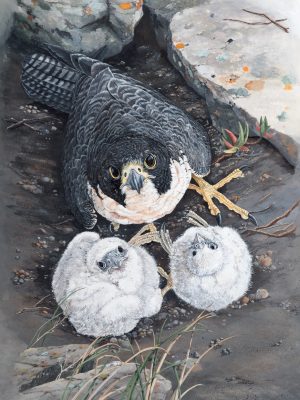
Limited Edition print size: 80 cm x 60 cm. Printed on 310 gsm Museum quality art paper.
'You're Late ' - Peregrine family (Falco peregrinus)
This female Peregrine was successfully rehabilitated at the Raptor Refuge of Tasmania, Kettering. A joy to watch and a very good news story.
The Peregrine Falcon is the embodiment of apex hunter; fastest animal in the world and master of the famous Peregrine ‘stoop’.
My portrait of Peregrine domesticity hopefully provides the viewer with a snapshot of another side to these magnificent raptors - that of protective maternal instinct and total commitment.
While the female incubates the eggs and the chicks newly hatched the family unit is fed on the nest by the male, hence her expression …’You’re Late’
(My sincere thanks to Luke O’Brien for his superb reference images)
This is a signed limited edition print.
*Price includes postage anywhere within Australia
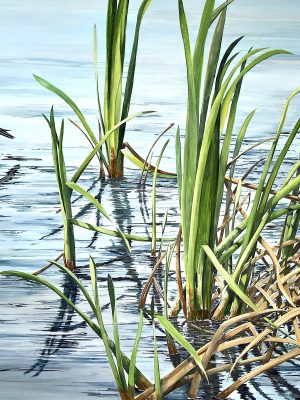
Limited Edition print size: 50 cm x 70 cm. Printed on 310 gsm Museum quality art paper.
'Reflections' - Welcome swallow
This is a signed limited edition print.
*Price includes postage anywhere within Australia
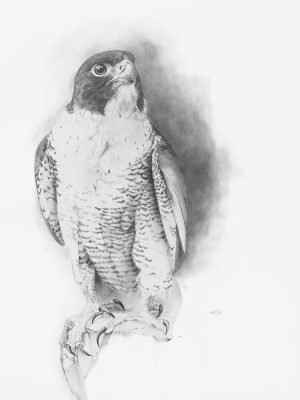
Peregrine falcon (Falco peregrinus)
All confirmed nests in Tasmania have been on cliffs. A site sheltered from heavy rain or high chill-factors is preferred and just a scrape is made to lay eggs.
Tasmania is a great place for peregrines but far from the best. The nesting population recovered from ravages of organochlorine pesticides in the 1960s, 1970s and into the 1980s, through legal protection in the early 1970s to now. With approximately 120 breeding pairs, the population has been relatively stable for some years now. Most are clustered in river valleys and along suitable coastline and on inshore islands and where close (< 4km apart) pairs tend to be evenly distributed due to their territorial nature. Nests are fiercely defended against all kinds of perceived threats and predators.
Size: A2 (59.4 cm x 42 cm). Printed on 310 gsm Museum quality art paper.
This is an archival print.
*Price includes postage anywhere within Australia
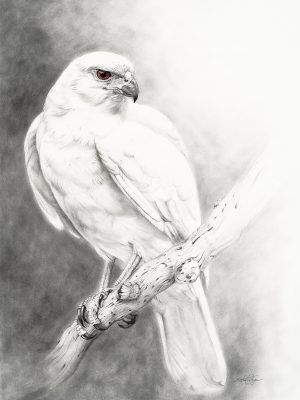
Grey goshawk - white morph (Accipiter novaehollandiae)
The grey morph has a pale grey head and back, dark wingtips, barred grey breast and tail, and white underparts. The white morph is the only bird of prey in the world to be entirely white.
Grey Goshawks are about 40–55 cm long, with wingspans of 70–110 cm. Females are much larger than males, weighing about 680 g. Males average 350 g.
Goshawks usually prey on mammals such as rabbits, possums, and bats. They may also eat birds, small reptiles, and insects. Females, due to their size, can catch larger prey than males.
Hunting is often done by stealth, and very successfully, but Grey Goshawks are willing to pursue their prey before catching it with their talons
Size: A2 (59.4 cm x 42 cm). Printed on 310 gsm Museum quality art paper.
This is an archival print.
*Price includes postage anywhere within Australia
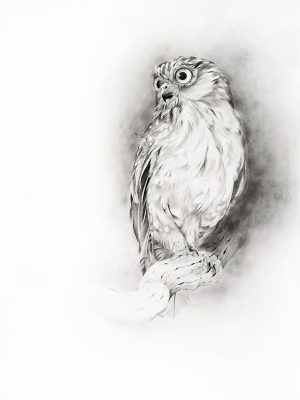
Southern Boobook owl (Ninox novaeseelandiae)
The Southern Boobook is the smallest and most common owl in Australia. It is identified by its plumage, which is dark chocolate-brown above and rufous-brown below, heavily streaked and spotted with white. The facial disc is chocolate brown and the eyes are large and yellowish. Tasmanian birds are smaller and more heavily spotted with white. Young Southern Boobooks are almost entirely buff-white below, with conspicuous dark brown facial discs. Like other owl species, the Southern Boobook is nocturnal.
Size: A2 (59.4 cm x 42 cm). Printed on 310 gsm Museum quality art paper.
This is an archival print.
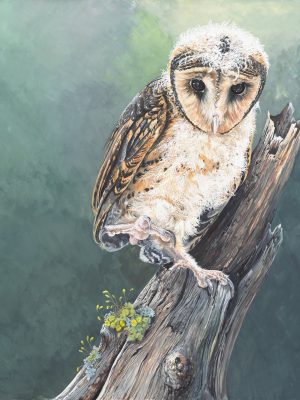
Immature Tasmanian Masked Owl (Tyto novaehollandiae castonops)
Montgomery (the owl) resides at the Raptor Refuge of Tasmania, Kettering. He enjoys educating school groups and takes his ambassadorial role very seriously.
(My sincere thanks to Luke O’Brien for his superb reference images)
This original piece is SOLD.
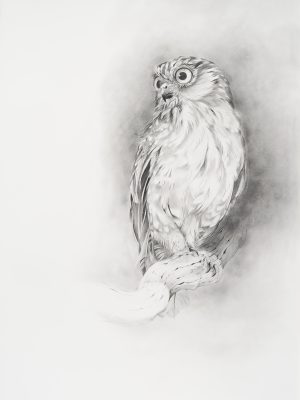
Southern Boobook owl (Ninox novaeseelandiae)
The Southern Boobook is the smallest and most common owl in Australia. It is identified by its plumage, which is dark chocolate-brown above and rufous-brown below, heavily streaked and spotted with white. The facial disc is chocolate brown and the eyes are large and yellowish. Tasmanian birds are smaller and more heavily spotted with white. Young Southern Boobooks are almost entirely buff-white below, with conspicuous dark brown facial discs. Like other owl species, the Southern Boobook is nocturnal.
This original piece is SOLD.
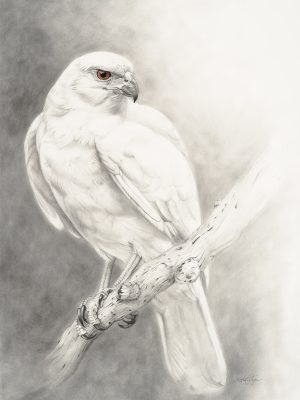
Grey goshawk - white morph (Accipiter novaehollandiae)
The grey morph has a pale grey head and back, dark wingtips, barred grey breast and tail, and white underparts. The white morph is the only bird of prey in the world to be entirely white.
Grey Goshawks are about 40–55 cm long, with wingspans of 70–110 cm. Females are much larger than males, weighing about 680 g. Males average 350 g.
Goshawks usually prey on mammals such as rabbits, possums, and bats. They may also eat birds, small reptiles, and insects. Females, due to their size, can catch larger prey than males.
Hunting is often done by stealth, and very successfully, but Grey Goshawks are willing to pursue their prey before catching it with their talons
This original piece is SOLD.
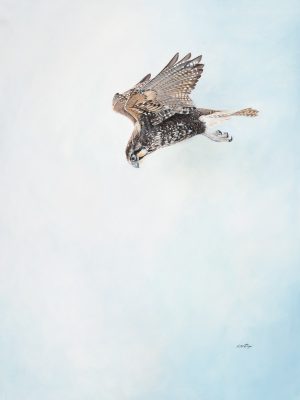
One of my favourite raptors. Usually around 40 cm to 50 cm long, they are found in light and dark forms and a variety of intermediates. They typically have red-brown heads with narrow black streaks with a light crown and off white chin. Wings are a spotted red-brown with dark brown quills. Beaks are light blue/grey, eyes are brown. The falcons make a loud cackle call uttered frequently. The brown falcon eats small mammals, including house mice and young rabbits. It also eats small birds, lizards, snakes and a variety of invertebrates particularly caterpillars, grasshoppers, crickets and beetles. Insects form the bulk of their diet during winter and the falcons often chase the insects on the ground!
(Sincere thanks once again to Clive Roper for his superb reference images)
This original piece is SOLD.
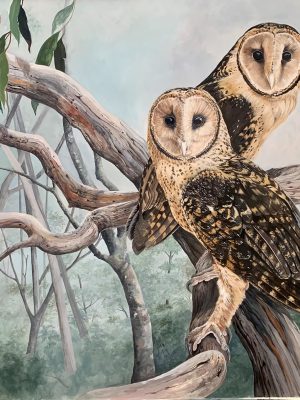
Tasmanian Masked Owls (Tyto novaehollandiae castonops)
Tasmanian Masked Owls are not only large, but robust. They weigh up to 1.26 kilograms with a wingspan of up to 129 centimetres. Their plumage is mainly a variable combination of browns and greys, generally darker than the other Australian subspecies. Females are considerably darker, as well as larger, than the males. They have broad, black-bordered, buff to chestnut facial discs, and fully feathered legs with powerful feet and long talons. The owls hunt at night, preying on a wide range of animals, from insects to mammals as large as rabbits, bandicoots and brushtail possums. (Sincere thanks once again to Dr Mehrdad Abbasian for his superb reference images)
Listed: Endangered.
This original piece is SOLD.

Tasmanian Wedge-tailed Eagle Nest (Aquila audax fleayi)
Wedge-tailed eagle nesting habitat is generally restricted to predominantly closed canopy old growth native forest, almost exclusively in tracts of tall eucalypt forest. Trees selected for nesting are among the largest in the locality, typically greater than 27 metres in height, with few exceptions. Nest trees normally occur on leeward slopes sheltered from prevailing strong winds.
The nest is a large structure of dead sticks, usually reused for years, often reaching considerable size. Nests 1.8 m across, 3 m deep and weighing about 400 kg are known. Nests have a shallow cup on the top, lined with fresh twigs and leaves. Sticks are added by a bird while it stands in the nest. If these sticks are dropped outside the nest, no effort is made to retrieve them. (With special thanks to Geoff ‘Hutcho’ Hutchinson for his fabulous reference images)
Listed: Endangered.
This original piece is SOLD.

Peregrine falcon (Falco peregrinus)
All confirmed nests in Tasmania have been on cliffs. A site sheltered from heavy rain or high chill-factors is preferred and just a scrape is made to lay eggs.
Tasmania is a great place for peregrines but far from the best. The nesting population recovered from ravages of organochlorine pesticides in the 1960s, 1970s and into the 1980s, through legal protection in the early 1970s to now. With approximately 120 breeding pairs, the population has been relatively stable for some years now. Most are clustered in river valleys and along suitable coastline and on inshore islands and where close (< 4km apart) pairs tend to be evenly distributed due to their territorial nature. Nests are fiercely defended against all kinds of perceived threats and predators.
This original piece is SOLD.

Feathers are epidermal growths that form a distinctive outer covering, or plumage on avian species. They are considered the most complex integumentary structures found in vertebrates and a premier example of a complex evolutionary novelty. As well as controlling flight and regulating temperature, they often attract more than just other birds with their beauty.
This original piece is FOR SALE. Please get in contact for more information.

Tasmanian Wedge-tailed eagle (Aquila audax fleayi) feather.
The average wingspan for the Tasmanian Wedge-tailed eagle is typically is between 182 and 232 cm. The largest wingspan ever verified for an eagle was for this species. A female killed in Tasmania in 1931 had a wingspan of 284 cm, another female measured barely smaller at 279 cm.
This original piece is FOR SALE. Please get in contact for more information.

This female Peregrine was successfully rehabilitated at the Raptor Refuge of Tasmania, Kettering. A joy to watch and a very good news story.
The Peregrine Falcon is the embodiment of apex hunter; fastest animal in the world and master of the famous Peregrine ‘stoop’.
My portrait of Peregrine domesticity hopefully provides the viewer with a snapshot of another side to these magnificent raptors - that of protective maternal instinct and total commitment.
While the female incubates the eggs and the chicks newly hatched the family unit is fed on the nest by the male, hence her expression …’You’re Late’
(My sincere thanks to Luke O’Brien for his superb reference images)
Award of Excellence - Holmes Art Prize for Australian Bird Art, QLD 2021
This original piece is SOLD. To view available limited edition prints, please click here.
Please get in contact for more information.
